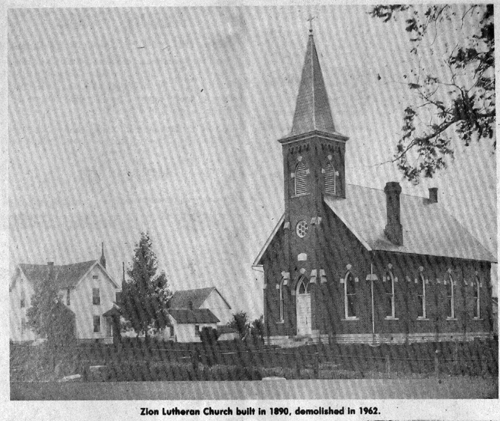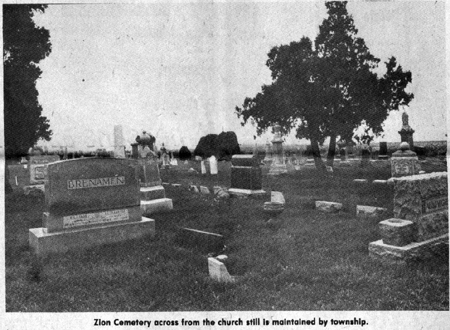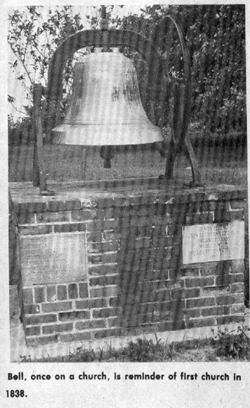October 22, 1981



Picture #1 – Zion Lutheran Church built in 1890, demolished in 1962.
Picture #2 – Zion Cemetery across from the church still is maintained by township
Picture #3 – Bell, once on a church is a reminder of first church in 1838
A human interest story emerged when I wrote the Hope Lutheran Church article, but available space permitted telling only part of it then. It pertains to Zion Lutheran Church and Zion Cemetery.
Recapping a portion of the earlier article: “The Zion Lutheran Church, organized in 1838, by Rev. Adolph Conrad, was located in Jackson Township, about five miles east of Fostoria. Back then there were only mud roads, but today the former church site and the old cemetery are easily reached on Seneca County Road 592, where it is intersected by County Road 39”.
“Originally, that pioneer group of Lutherans used a log structure as a school and church. In 1852, they built a larger frame structure, which served until 1890, at which time the church shown in the accompanying photo was erected. It served the Zion congregation until 1962, when they united with Hope Lutheran Church. Later, the church was demolished, but the site is maintained as part of the old parsonage land, now owned by the Kermit Woessner family, who belonged to Zion Church. In a way it provides a memory of those early Christians who organized the church and kept their faith”.
CEMETERY MAINTAINED
Some weeks ago when I visited the site and Zion Cemetery just across the road, a young man, working for the township trustees was mowing the grass. He stopped briefly to talk. He said there are still a few burials each year in the cemetery. They are descendants of the pioneer family who settled in that area and purchased family plots many years ago.
In the accompanying photo showing the church, can be seen the parsonage and other buildings which still stand today from the earlier time when the church was photographed. The Kermit Woessner said at least 50 of her ancestors are buried in the cemetery across the road.
The names on the plaque, which is part of the brick structure where the old church bell is preserved (shown in another photo), are of the building committee back in 1890. They are Jacob Heiserman, George Yochum, Ephraim Stahl, William Kassing, Jacob Stainbrook, and Rev. George Dillman, the pastor who served both the Zion and Hope Lutheran churches at one time.
And, the cemetery has many descendants of that committee buried in it, and many others whom readers may recognize, such as: Fraver, Amaugher, Stultz and others shown in the list later in this article.
BELL CAST 1890
About the old bell. It was cast by H. Stackstede & Co., St. Louis, Mo. in 1890. It seems too bad that it isn’t in use, and ironic that they built those old bells to last so long, yet they aren’t being used.
I always thought it was comforting to hear the many church bells peeling out their melodious tones on Sunday and other times, reminding the listeners that the church was still there to save and to serve all mankind. A silent bell like a muted tongue…its message no more being sounded.
As I write this article, I think about Rev. George Dillman who served both the Zion and Lutheran churches for 24 years, walking the distance of five miles from Fostoria to Zion every Sunday to conduct two services and then back again to do the same at Hope. Perhaps it was his consecration and loyalty to God that gave him the strength to carry on such a strenuous schedule all those years. At the end of 24 years, he gave up the Zion Church but devoted another 10 years to Hope.
MANY VISIT GRAVES
I was told by C.T. “Ted” Fraver, 302 College Ave., that descendants of those who belonged to the Zion Church and are buried in the cemetery there, often return on Memorial Day, and on other occasions when they visit here to pay respect to their departed ancestors.
Zion must hold fond memories for many.
Perhaps the photos with this article will be cherished and help to keep those memories alive.
The Woessners told me that during the 26 years they have lived in the house that was the parsonage, they have received many letters and telephone calls from far away places from descendants of those buried in the cemetery years ago, inquiring if the graves are marked and for other information about graves, death dates, etc.
Unfortunately, the Woessners said some of the graves never had markers; others were of sandstone which have deteriorated from weather and cannot be read; and still others have been vandalized.
OLD MARKERS 1813, 1816
The oldest marker the Woessners ever found in the Zion Cemetery was dated 1813. The oldest date I found was on a marker barely readable, but I concluded with certainty the name – Robertson – the date was 1816. I was surprised to find one prominent marker – Foster – and many smaller ones surrounding if for the family. Naturally, I wondered if those buried there were related to the Fosters after whom Fostoria was named. The Fosters did own a farm just east of Fostoria on McDougal Road. Therefore, it is reasonable that they could have been buried in Zion, I’ll look into it.
Two of the Foster markers were produced by the W.D. Robbins Co., and their name was at the base of the marker. They had a marble shop back in Fostoria during the late 1800’s. It was located in the tri-angular building at Perry and Main streets, prior to occupancy by The Fostoria Times. The building was demolished during the mid 1940’s after The Fostoria Review purchased The Times.
IN MEMORY OF…
Here are additional names I observed walking through the cemetery: Yochum, Shaw, Anderson, Shuff, Youngston, Rosen, Stainbrook, Rinebold, Nusser, Heiserman, Brenamen, Puffenberger, King, Bigham, Bell, Shults, Stull, Keller, Stahl, Winters, Hofman, Hampshire, Kline, Longnecker, Wolfarth, Butzier, Pankhurst, Trumbo, Argabrite, Stagger, Bethel, Stombaugh, Trautman, Gee, Kassing, Dreitzler, Powell, Iler, Lambright and Rady.
FEEDBACK: THE BEARS STORY
Correction: When that story appeared, Mrs. William Murphy telephoned to call my attention to two errors. Incidentally, John Peters, was her grandfather. He was in the contracting business, lived on Sandusky Street and got the bears from Eicher. It was his brother who was in the waste matter collection business. Secondly, Mrs. Murphy said her grandfather did finally purchase the bears from Eicher, the original owner, and had documents recording the sale.
LEEDY DRUM STORY
Steven E. Rowe, 617 S. Countyline Street liked the story. Here’s a note from him:
“I was surprised and pleased to read your article on Mr. Leedy. As a working drummer and citizen of Fostoria, I’d like to thank you for your interest and investigation of Mr. Leedy and his craft. His drums are collectors items and are still used by some of the finest drummers today. I’d love to get my hands on one of his wood snare drums. Thank You”